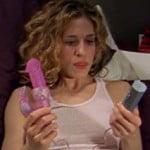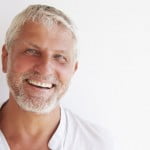SAMANTHA Anderson had a busy weekend ahead, making jewellery in the workshop at her Brisbane home while her husband looked after their three kids.
She had taken her breakfast, peanut butter on toast, to eat in the studio, but for some strange reason, she couldn’t get a single bite down.
“I went to swallow and I couldn’t,” she told news.com.au. “It didn’t happen. I choked.
“I was confused, and ended up having to cough it out. I tried a few more times. That gulp just didn’t happen.”
Sam was shaken, but brushed off what had happened — until she couldn’t eat again at lunchtime, and dinner. By the end of the day, she was starving.
“I told myself, ‘don’t think about it, you’re only going to make it worse,’” said the 40-year-old. “I didn’t want to let myself get fearful for the next mouthful.”
But Sam’s frightening problem wasn’t going anywhere.
The doctor told her she was stressed and needed valium. When that didn’t work, he prescribed anti-depressants a few weeks later. None of it felt right to the businesswoman and mother of three, who loved her job and home life, and didn’t feel worried about them.
She bargained with the doctor “to buy herself time”, trying hypnosis and counselling and taking a step back from her work responsibilities.
One day, she arrived at the doctors with such low blood pressure that she was put straight in an ambulance and taken to hospital.
Specialists tested her for motor-neuron disease as well as mental health disorders. Finally, after four months, they diagnosed dysphagia — a rare condition in which patients lose the ability to swallow.

Sam, centre, on holiday in New York before she had dysphagia with her husband, two daughters and son.

The 40-year-old was taken to hospital shortly after she stopped eating.

A meal from a feeding tube.
‘I’D WAKE UP CHOKING ON MY OWN SALIVA’
Sam’s life had become a living nightmare. She learnt to eat foods with a soft texture, like custard or yoghurt, and push them to the back of her throat while she waited for her swallowing mechanism to kick in. Half the time it would take too long, and she would cough up her food.
“I’d get three-quarters of the way through a tub of yoghurt and would have choked 20 times. My hand would be shaking so much I couldn’t keep going, I’d have to try again in a few hours.”
She stopped seeing friends, and wore loose clothing to hide the fact her weight had plummeted from 60 to 45 kilos, but her children could see something was very wrong. She often woke up in the night to find them standing over her tears, begging her not to die.
“It was very surreal, I felt like Alice in Wonderland, fallen down the rabbit-hole,” she said. “It felt like a dream.
“The whole day became a battle for survival. I thought, ‘I’m going to starve to death or choke to death, either way it’s coming for me.’
“My life, my world had been devastated. I had nothing positive to say anymore. I was a hermit.”
Some friends told her she looked great, and that they wanted to be on her diet. Sam was horrified. “I was a 40-year-old mother weighing less than I did at 14.”
After nine months, doctors realised that a painful rash Sam had experienced in her left ear shortly before she lost the ability to swallow had been shingles. Left untreated, it had damaged four of her cranial nerves, triggering her dysphagia.
A dietitian put Sam on a liquid diet of 13 drinks a day, each high in calories, vitamins and minerals. “It would take me half an hour or 45 minutes to get one down. Sometimes it was like, as soon as you got the drink down, you’d look at the time and in half an hour you’ve got to do it again. I’d think ‘Why am I fighting through the day just to get up and do it again?’
“I’d wake up at night choking on my own saliva.”

Before Sam got ill.

The mother of three having electrical STIM treatment to reduce pain.

Sam and her family finally have hope for the future again.
TOO DANGEROUS TO EAT ALONE
A year and a half after the problem began, it became clear Sam was suffering from malnutrition. Her hair was falling out, her skin was dry and her dry mouth had wreaked havoc on her teeth. She was anaemic and at as much risk of heart failure as a morbidly obese person.
Doctors inserted a feeding tube into her belly button for 18 months so she didn’t need to eat. They monitored her swallowing mechanism on film, and found it was as weak as that of a 90-year-old.
Having exhausted the help available in Australia, she and her husband looked online and found a specialist in the US, Professor Peter Belafsky, director of the University of California at Davis Voice and Swallowing Center. He has described the condition as “like being constantly waterboarded” as patients struggle to swallow their own saliva.
Four years on, Sam has learned to eat some foods that can be chewed with water until they become liquid, including mashed potato, cake and bread without grains. She can’t eat mincemeat or anything fibrous, and she cannot eat alone, because “it’s too dangerous.”
She works from her studio now, despite her previous love of interacting with customers, and her husband comes home every lunchtime to help her eat. Each meal is an exhausting ordeal of “non-stop chewing and swallowing and head positioning and throat clearing and keeping your airway clear and managing spillage and trying to keep a track of where the food in my mouth is,” Sam wrote in a heartfelt article on the Swallowing Disorder Foundation’s website.
The wife and mum says she’s realised who her real friends are. “People were using words like ‘phobia’ and ‘breakdown’,” she said. “I felt judged and betrayed by the people that should have known me better than that.
“There are definitely days when I don’t want to get out of bed … But when I think about how far I have come, what I can manage to eat now compared to a year ago, two years ago, I am so happy.”
Sam has signed up for stem cell trials with Prof Balafsky next year. She hopes that may help her improve further, although she is unlikely to ever be able to swallow without thinking.
One thing is certain, she will never take for granted any simple thing her body can do.
[SOURCE :-news]




